- 2.6Impact Factor
- 5.1CiteScore
- 30 daysTime to First Decision
Physical Education, Physical Activity and Human Health
Special Issue Information
Dear Colleagues,
The importance of physical education and physical activity is unquestionable. They positively influence the functioning of the body, providing multiple benefits at therapeutic and preventive levels. It is therefore important to promote healthy lifestyles for optimal human health.
Following the success of the previous edition, this Special Issue aims to disseminate national and/or international research studies on the topics of physical education, physical activity and human health. We aim to highlight the relevance of these studies in addressing various issues and contribute to a better understanding of these topics.
We welcome submissions on the above topics in the form of: reliability studies, validity studies, correlational studies, observational studies, study protocols, longitudinal studies, cross-sectional studies, case reports, qualitative studies, studies with discourse analysis, bibliometric reviews, narrative reviews, scoping reviews, systematic reviews and meta-analyses.
Topics of interest include:
- Physical education;
- Physical activity;
- Human health;
- Exercise or sport and health;
- Welfare;
- Healthy habits;
- Gender and sport;
- The political economy of sport;
- Sport;
- Corporal expression;
- Inclusive and adapted sport;
- Physical literacy;
- Fitness tests.
Dr. José Carmelo Adsuar
Dr. Roxana Paola Palacios Cartagena
Dr. Carmen Galán Arroyo
Dr. María Mendoza Muñoz
Guest Editors
Manuscript Submission Information
Manuscripts should be submitted online at www.mdpi.com by registering and logging in to this website. Once you are registered, click here to go to the submission form. Manuscripts can be submitted until the deadline. All submissions that pass pre-check are peer-reviewed. Accepted papers will be published continuously in the journal (as soon as accepted) and will be listed together on the special issue website. Research articles, review articles as well as short communications are invited. For planned papers, a title and short abstract (about 250 words) can be sent to the Editorial Office for assessment.
Submitted manuscripts should not have been published previously, nor be under consideration for publication elsewhere (except conference proceedings papers). All manuscripts are thoroughly refereed through a single-blind peer-review process. A guide for authors and other relevant information for submission of manuscripts is available on the Instructions for Authors page. European Journal of Investigation in Health, Psychology and Education is an international peer-reviewed open access monthly journal published by MDPI.
Please visit the Instructions for Authors page before submitting a manuscript. The Article Processing Charge (APC) for publication in this open access journal is 1600 CHF (Swiss Francs). Submitted papers should be well formatted and use good English. Authors may use MDPI's English editing service prior to publication or during author revisions.
Keywords
- health
- physical activity
- exercise
- culture
- sports performance
- sports training
- health promotion
- health
- inclusion
- health-related quality of life
- obesity

Benefits of Publishing in a Special Issue
- Ease of navigation: Grouping papers by topic helps scholars navigate broad scope journals more efficiently.
- Greater discoverability: Special Issues support the reach and impact of scientific research. Articles in Special Issues are more discoverable and cited more frequently.
- Expansion of research network: Special Issues facilitate connections among authors, fostering scientific collaborations.
- External promotion: Articles in Special Issues are often promoted through the journal's social media, increasing their visibility.
- e-Book format: Special Issues with more than 10 articles can be published as dedicated e-books, ensuring wide and rapid dissemination.

